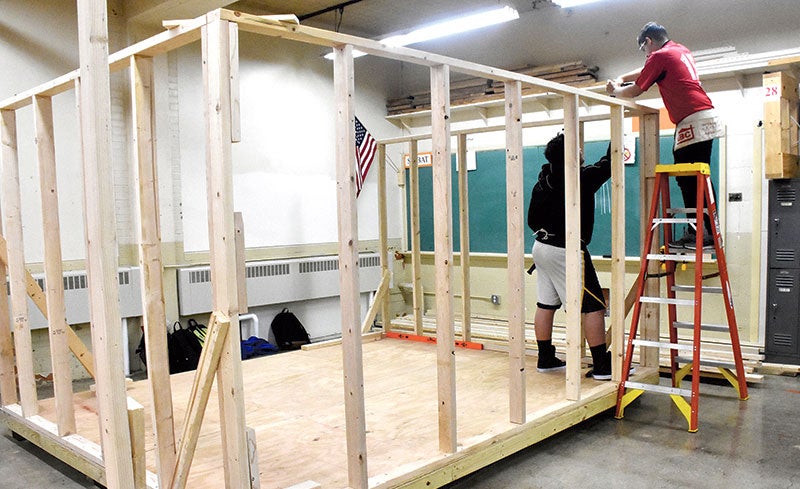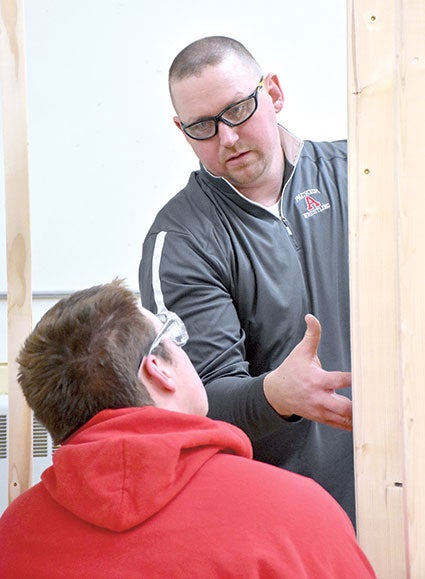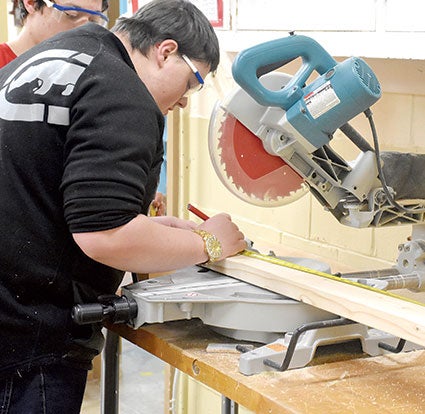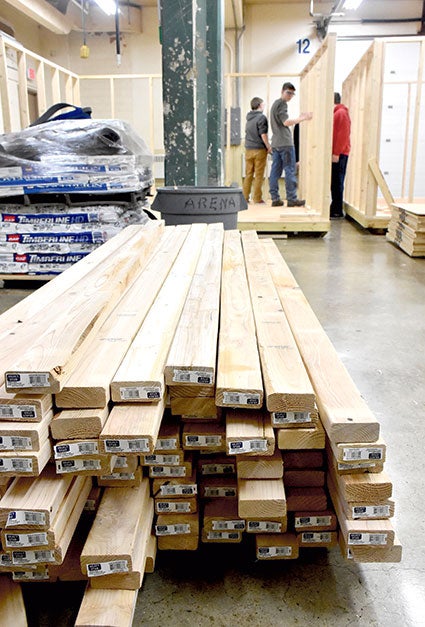Hammer and Nails; Offering kids options for trades careers
Published 7:48 am Tuesday, March 13, 2018

- Foreman Hector Hernandez, atop the ladder, works to secure a corner of a salt box shed as part of a carpentry class at Austin High School. Teacher Mark Winkels would like to offer a curriculum that would include work to earn real apprenticeship hours. Photos by Deb Nicklay/deb.nicklay@austindailyherald.com
Mark Winkels isn’t going to tell his students what they should do with their futures – but he is working hard to show them their options.
Not the least of which is entering the workforce with a skilled trade.
On this day, the industrial arts’ carpentry classes are building “salt box” sheds — and while the class is not new, he and others are working to broaden awareness of the need for skilled workers in Minnesota. They are also working to offer a new curriculum that would give students a leg up in entering the workforce.

Instructor Mark Winkels discusses a point of measurement on a salt box shed.
That proposed curriculum would allow students to use high school hours toward an apprenticeship carpenter program. A traditional apprenticeship program provides training in different job skills, with so many hours needed to advance through levels. Students in the program would be able to use their classroom hours toward those requirements, by completing three carpentry texts required by the industry.
The curriculum has yet to be approved by AHS administration, but Winkels is hoping it is in place by next fall. Students would most likely need to be juniors and seniors, Winkels said.
“These classes give our students real world applications. We expose them to a skilled trade – we’ve lost that focus in our society. The fact is, our students can earn a very good living with these skills.”
In this area, an average carpenter’s pay is in the $48 an hour range, he said.
“There seems to have always been a stigma attached to these careers — but that was a different era. It pays well; is little or no college debt and the need today is huge,” he said.
He’s got a lot to support that claim.

Spencer Hunt and Kyle Morgan work on cutting some of the lumber needed in the salt box sheds, under the direction of AHS instructor Mark Winkels.
Photos by Deb Nicklay/deb.nicklay@austindailyherald.com
An industrywide survey of more than 1,600 construction firms by the Associated General Contractors of America (AGC) and engineering software maker Autodesk found that 70 percent of construction firms across the United States reported that they are having “a hard time” filling hourly craft positions that represent the bulk of the construction workforce, according to a Star Tribune report last fall.
“In Minnesota, the squeeze was even more acute, with 78 percent of the 40 companies answering the survey indicating they were having trouble filling craft labor positions. The hardest workers to find: heavy equipment and crane operators, carpenters, work crew superintendents and truck drivers,” the newspaper said.
Over the course of the current curriculum of working on the sheds at AHS, students learn to read blueprints, how to measure, how to convert to fractions, estimating skills, roof slope, door installation, safety and teamwork.
Students, who range in grade from sophomores to seniors, also learn about cost comparisons in purchasing lumber and other materials. They work in five groups over two classes, with three to four students working on each shed. Each group has a foreman, chosen by Winkels.
One of those foremen is Hector Hernandez, 16, who took the class “to see what careers I might get into,” he said.

Students at Austin High School work on salt box sheds, which helps build a number of carpentry skills, from measuring and estimating, to cost comparison and how to read blueprints.
He likes the exactness of the job – “if you mess up one thing, it could affect everything,” he said — and he feels he works well with others.
“I am curious and I ask questions,” he said. “I think I was chosen as a foreman because last semester, I got my work done on time and I think I have a pretty good attitude.”
Fellow sophomore Spencer Hunt, 16, said he realized that carpentry “would be a really good career.”
“I don’t know if I’ll do that, but I know it could be good; and I really like to work with my hands.”
The classwork results in three, 10-by-12 sheds, which sell for $1,800 and two, 8-by-10 sheds at $1,500. All are sold and mostly used as backyard sheds.
“We usually have some that are pre-sold,” said Winkels. “This year, they’re all for sale.”
Those interested should contact Winkels at mark.winkels@austin.k12.mn.us





